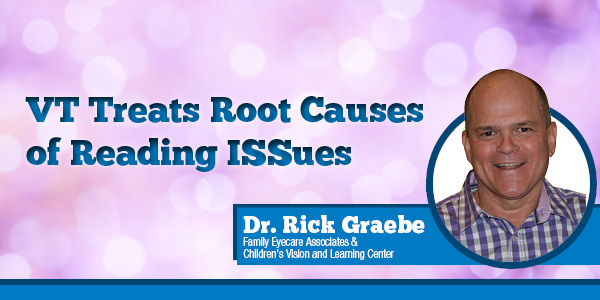VT Treats Root Causes of Reading Issues
Does Dr. Graebe, a behavioral optometrist in Versailles, claim to cure dyslexia, ADD or other learning differences? No.
He recognizes that these are legitimate diagnoses that identify a cluster of behaviors. But he also says these terms are overused and result in the mislabeling of people, especially schoolchildren who struggle in the classroom.
What Dr. Graebe does claim is that his practice, which uses Vision Therapy, treats the underlying issues behind those series of behaviors. And that results in dramatic improvement for his patients.
Vision Therapy performs so well because more than 85% of school work involves the visual system, and VT is a kind of physical therapy for the eyes, brain and body.
“People with convergence insufficiency are three times more likely to have a diagnosis of ADD,” Dr. Graebe says.
CI is the inability of the eyes to work together when looking at close-up objects.
When the visual system is required for tasks such as reading, writing or working on a computer, one eye will turn outward instead of inward creating double or blurred vision.
A child with CI will almost certainly struggle to read, which all but guarantees poor performance in the classroom.
“CI is the most common eye tracking problem I see,” says Dr. Graebe, who estimates that 90% of the patients who come to him have the condition, sometimes by itself and sometimes in conjunction with other functional vision conditions.
“When it comes to close-up work, some kids haven’t learned how to keep their eyes converged to focus on words and track them across the page.
“That’s why some kids have no joy for reading and avoid it whenever they can.”
At Dr. Graebe’s office, patients undergo a thorough exam of their visual system. If necessary, he recommends other therapies such as occupational therapy.
“I think OT works great but after the age of 3 or so, we can have a bigger impact than any other therapy out there,” he says.
Routinely, after 30 weeks of Vision Therapy, students see improvements of up to three years on standardized visual skills testing.
In addition, Vision Therapy, like other therapies, creates pathways in the brain that last a lifetime.
VT takes time and effort but the results are undeniable. For many bright kids who complete the therapy, their performance now matches their abilities.
“I love it when that happens,” Dr. Graebe says. “My passion and joy is to help people reach their potential. So I’m in the right place doing the right thing.”

